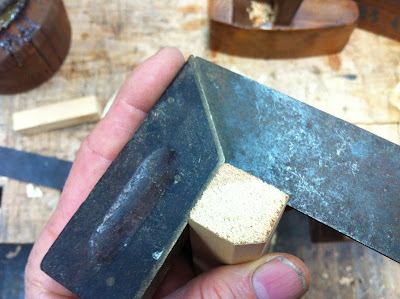So I set out to make a dovetail joint immediately to see what the challenge was and how difficult it would be. The first decision was whether to make the tails first or make the pins first. Half the people I talked to said one thing and half said the other. I really don't think it matters, and after all these years, I just do what I feel like at the time. As for the transfer of the lines, that is a question of technique and tool choice. Which method works best is determined by personal experience. The best argument I have for cutting tails first is that it is easier to adjust the pins last since they are end grain.
I remember Frank Klausz on his video talking about the first time he made a drawer, and his father took it and threw it into the corner. When I completed my first "drawer" test with full dovetails and half blind dovetails, I threw it into the corner. Since I have never moved the shop in 40 years, it still sits in the corner, reminding me of my start. Here is a photo of that effort.
 |
| My First Dovetail 1969 |
Soon I will be on a national television show, which the non disclosure contract I signed prevents me from naming. It is a new "reality" show on a network which is just entering the reality show genre for the first time. The show is about determining if something is real or fake.
I was asked to analyze a Civil War table and determine if it belonged to Lincoln or not. Before I went to the taping, I searched out the patent copy for the Knapp dovetail, since that distinctive dovetail was typical of the post Civil War furniture. You see, the Industrial Revolution transformed all aspects of furniture making during the mid 19th century, and creating a machine to make a dovetail was the last task that was resolved, first by Mr. Knapp, and soon after by many others. The first patent by Knapp was 1867, but the 1871 patent was the one which made him famous, and his invention was quickly adopted by factories and used on most furniture for a decade after that. I'm sure you have seen it. It is a half round shape with a pin in the center.
 |
| Knapp Patent Dovetail |
The instant I pulled out the drawer and pointed out the distinctive dovetail, I concluded that Mr. Lincoln did not live long enough to ever lay eyes on this table. The director stopped me and said that, since the show was an hour long, I would have to find some way to delay my conclusion and focus on other aspects of the table. That's called "leading the witness."
 |
| Layout Is Important |
Today I started framing the carcase for my fifth tall case clock, with the period works by Daniel Lecount. I mentioned these works some time back on this blog, and now have the time to build the case. I am duplicating a case which I found online that is by Lecount, and it is like the other marquetry clocks I have built in the past.
 |
| Small Marks Prevent Problems |
Building a tall case clock starts with the back board. That is the spine which all the other parts are attached to and it is the best place to start. Tall case clocks are rather easy to build. You have a box on the bottom, a box with a door in the middle, and a box on top which covers the works. All the rest is just surface decoration.
 |
| Note The Mitre Edge |
Today I made the bottom box. I am using white oak for this clock. In the past I used beech, pine, tulip poplar or white oak. I do not use red oak. Just don't like it. White oak is nice, but the French oak is even better, if you can get it. I am using American white oak, since I have some left over from a recent job making a desk.
 |
| Pins And Tails Properly Cut |
The box on the base of the clock has horizontal grain. If you use vertical grain there is a good chance it will eventually crack and spoil the marquetry. With horizontal grain, the clock just becomes slightly shorter as it ages. Less chance of cracking, in my opinion.
 |
| Nothing To See Here |
This also allows the use of full blind dovetails in the corners of the box. Full blind dovetails are perfect for making something which is veneered. They are structural, but do not telegraph through the surface veneers as the wood moves. The corners are nicely mitred and make a clean surface for the veneer. I use thick sawn veneers which are 1.5mm thick, but even at that thickness I have seen antique furniture where the dovetail pins show under the veneer as the wood ages.
Making full blind dovetails is a neat and rewarding job. It requires careful measurements, clean cutting with sharp chisels, and good sawing technique. Actually, I find it doesn't take much longer than a regular half blind dovetail, once you do it a few times.
The really cool thing about it is that, once it is done, it is never seen again. Only the maker knows about it and there is no reason to show it off or point to it with pride. It is the perfect zen joint. It takes skill, knowledge and confidence to accomplish, and then disappears forever.
Talk about the "mysteries of the trade!"











